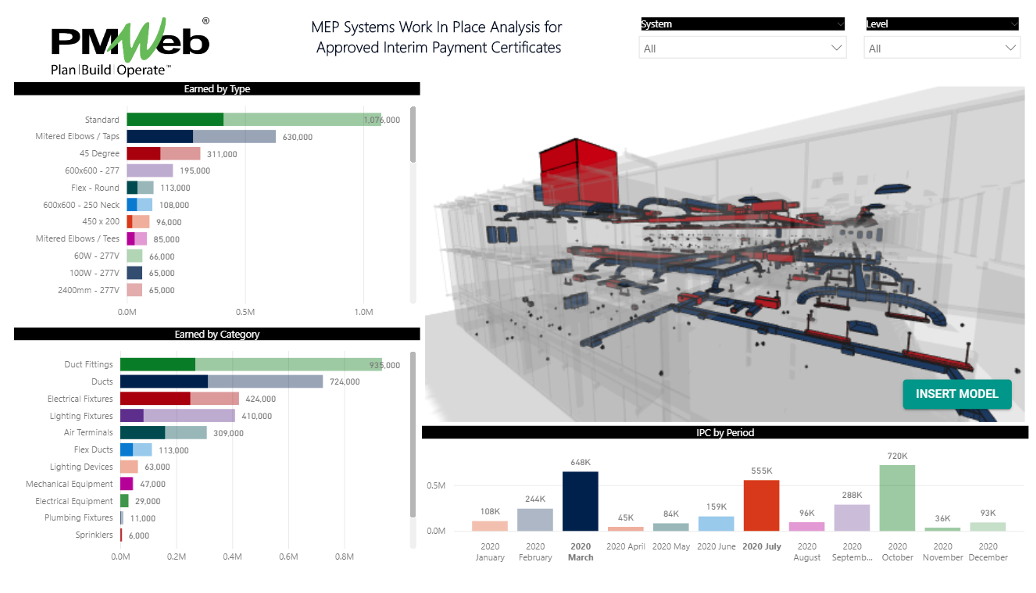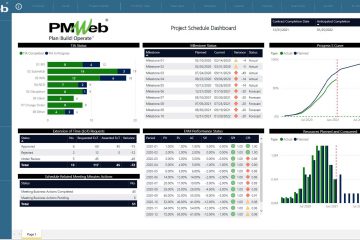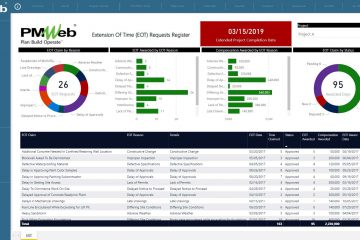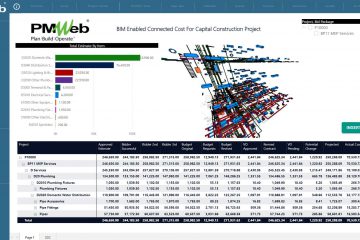One of the advantages that Building Information Modelling (BIM) brings to the delivery of capital construction projects is to enable project stakeholders who are not of the BIM development, review, and approval process to better visualize the project’s scope of work as it relates to their own activities. The BIM model, regardless of its level of detail, will improve the ability of those stakeholders to visualize and associate what they are used to view as forms and reports with the project’s different building systems and assets. The BIM model can be associated with the data captured for cost estimates, project schedule, material submittals, procurement, work inspection requests, testing and commissioning, and including interim payment certificates.
The interim payment certificate (IPC) is the process used on capital construction projects to quantify the amount earned by the contractor or subcontractor for approved work in place. This quantification needs to be in accordance with the bill of quantity (BoQ) or schedule of values that are part of each awarded contract or subcontract agreement. The quantities of the work in place can be done using what is known as the joint measurement report (JMR) which will be used to update the interim payment certificate or just update the interim payment certificate directly.
To ensure that the interim payment certificate (IPC) details can be viewed on the BIM model, each item in the bill of quantity (BoQ) or schedule of values should have a field to capture the BIM ID value used to identify the different objects and assets in the BIM Model. Using a Project Management Information System (PMIS) like PMWeb which has all modules needed to capture awarded contracts, joint measurement reports and interim progress invoices along with the BIM model created in Autodesk Revit and MS Power BI will provide the platform to visualize the details of approved work in place for each interim payment certificate. This solution will also need the 3DBI visual developed by KG-DEV called 3DBI (https://kg-dev.be/) will be used to display the BIM model in MS Power BI.
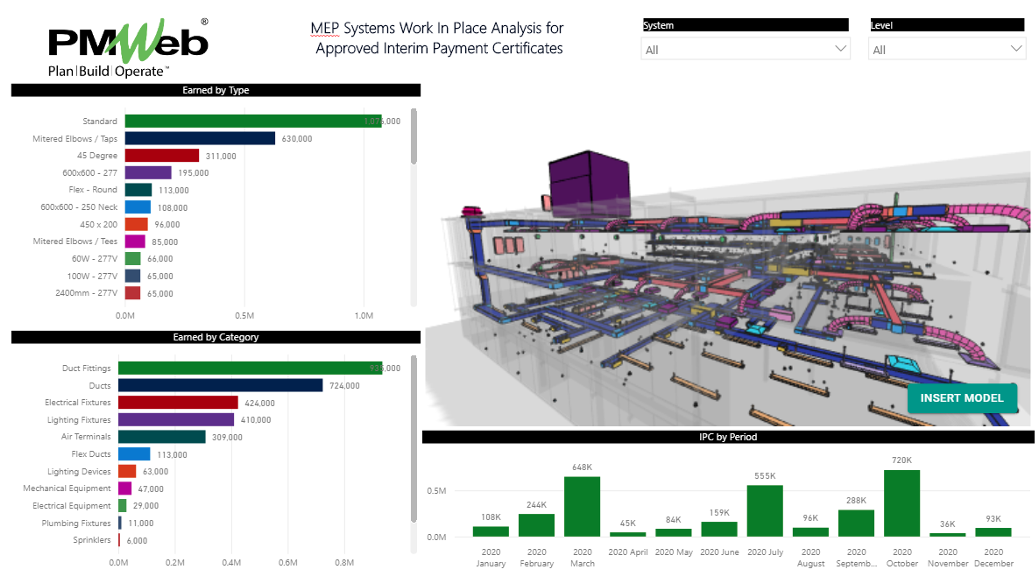
PMWeb will be used to capture the details of each interim payment certificate for each awarded commitment contract. For example, the contract for the electro-mechanical scope of work will include all mechanical, plumbing, HVAC, electrical, fire alarm, fire protection, lighting fixtures, and other systems that could be covered in the awarded contract. The level of details of the bill item will depend on the level of control that the entity wants to have. For example, the mechanical exhaust system can be grouped as one system, broken down into multiple systems, or even broken down to the level of the duct fitting and where it is located. Of course, this also needs to take into consideration the level of detail of the BIM model for MEP systems.
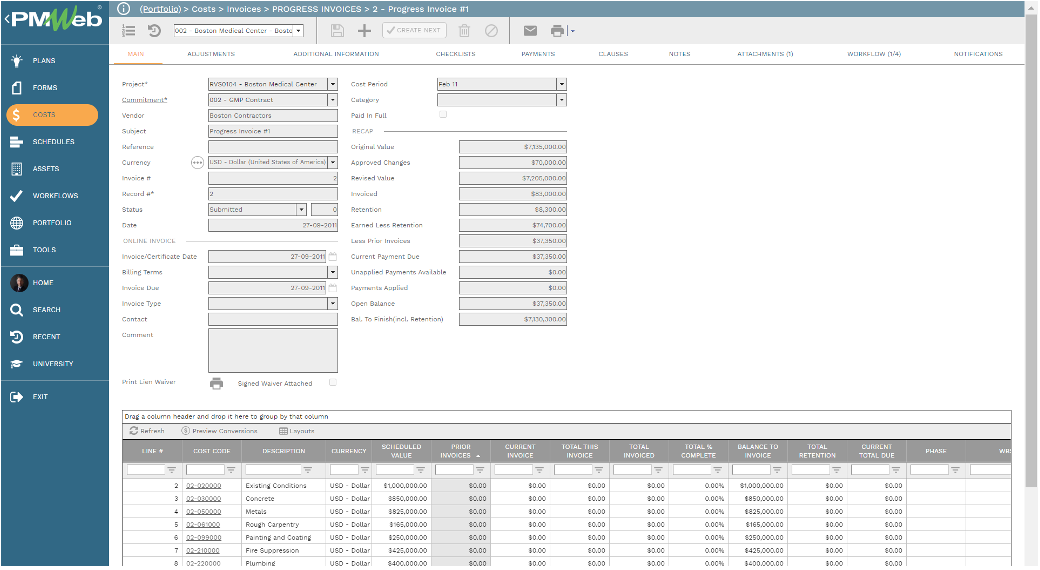
Each interim payment certificate transaction will have the option to attach the transaction with all supportive documents as well as be linked with other relevant PMWeb records and imported MS Outlook emails. The attached documents can be uploaded and stored in their relevant folder or subfolder in the PMWeb document management repository. Permission rights can be assigned to those folders to limit access to only those individuals who have been authorized to have the access to either only view or also edit.
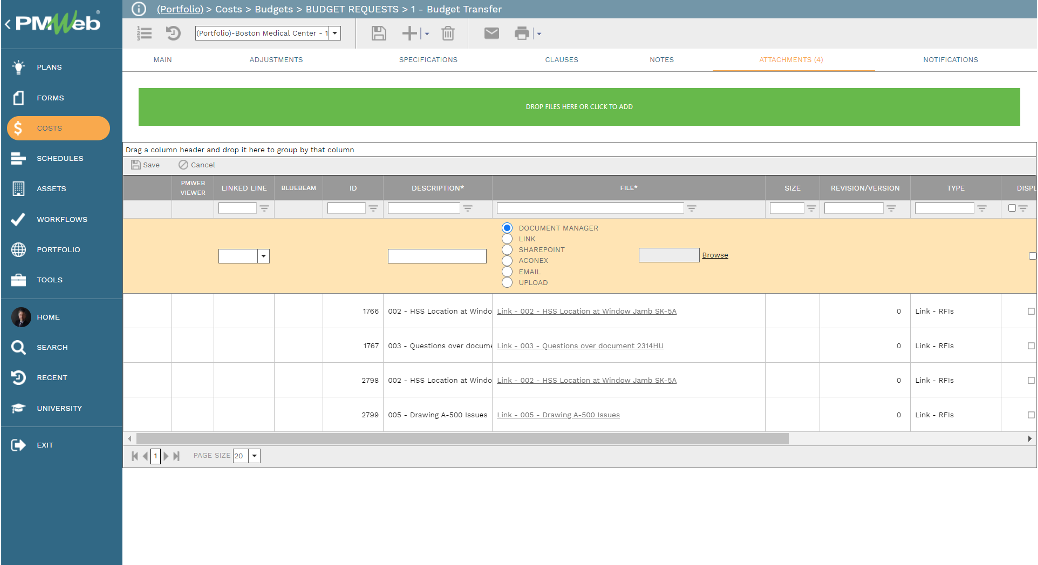
To enforce accountability and ensure trustworthiness in the data provided for each interim payment certificate transaction, a workflow will be created and assigned to this process to ensure that the details of all reviews and approvals for every single transaction are captured and documented. PMWeb workflow will be used to create the workflow that will map the submit, review, and approvals tasks along with the duration set for each task and the individual accountable to perform the task. Conditions can be also added to the workflow to enforce the approval authority levels which are usually part of the interim progress invoice submission.
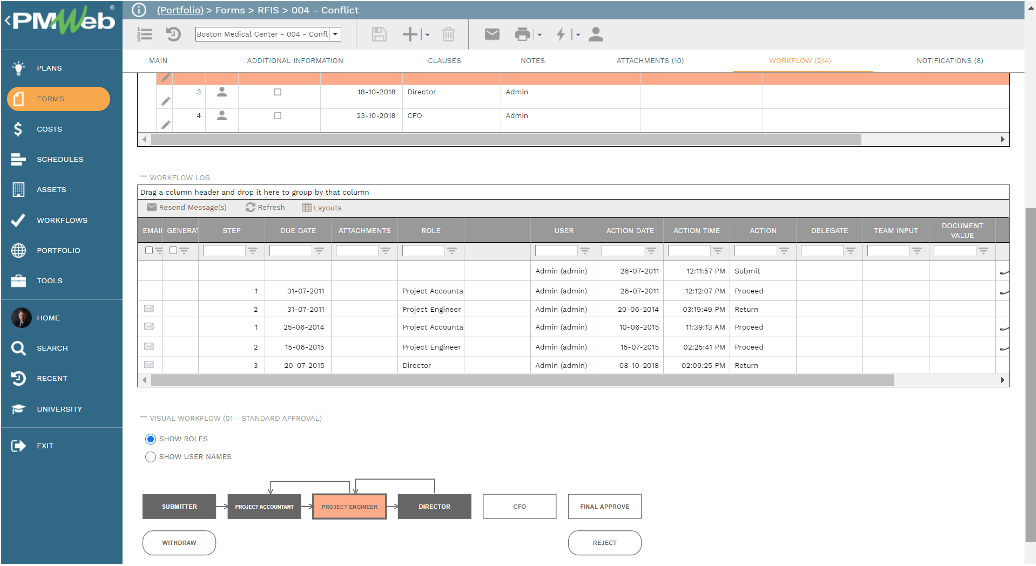
The interactive dashboard will enable the commercial management team, internal audit and other stakeholders to select from the “IPC by Period” histogram the period for interim payment certificate for which there is need to understand the details of work in place items approved at the period and where they are located on the project.
For example, if the interim payment certificate for the month of March 2020 was selected from the histogram, the BIM model visualization will automatically adjust itself to reflect the selected approved work in place. In addition, the two other visuals for the interim payment certificate by system type and by category will also get automatically adjusted to reflect the breakdown of the selected interim payment certificate.
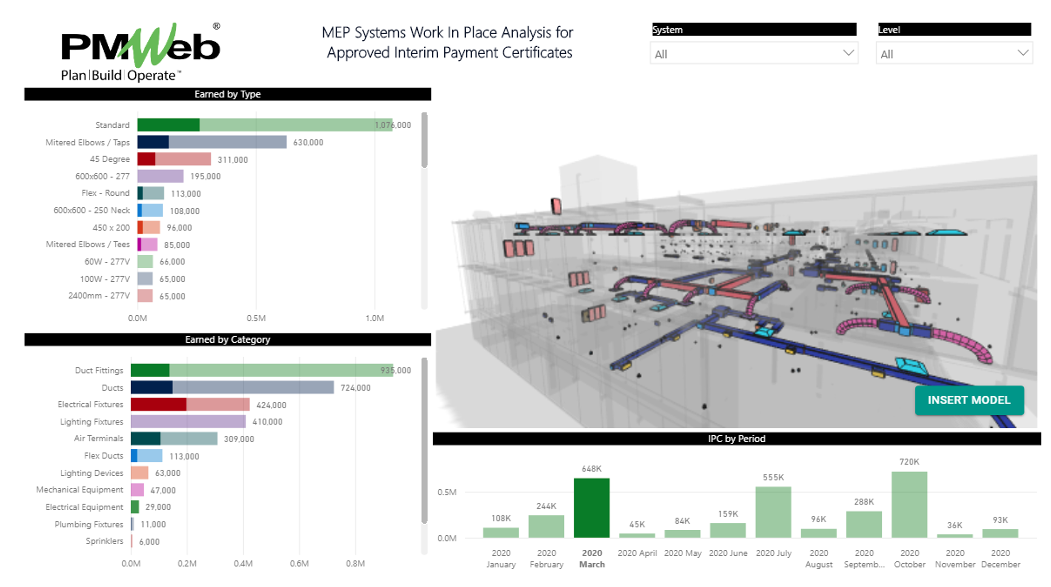
The selected information displayed on the BIM model can be further filtered by selecting which electro-mechanical system the report reader wants to visualize. For example, if the requirement is only to visualize the mechanical air supply systems, the filter for systems will be used to only select the mechanical air supply systems. When this is done, the BIM model and the three other visuals for IPC By Period, Earned By Type, and Earned by Category will be automatically adjusted to reflect the interim payment certificate value for that period covering this system only. The report can be further refined if the report reader wants to limit the selection to a specific floor level for which the relevant value will be selected from the Level filter.
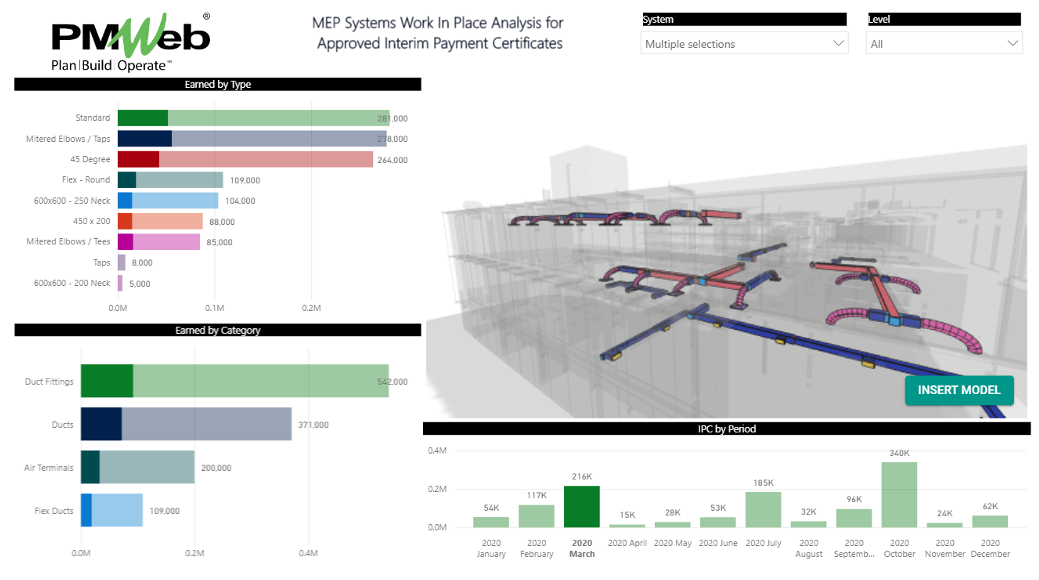
The commercial management team and other project stakeholders can also view the details of the interim payment certificate values for a specific system category, for example, ducts. By selecting the “Ducts” in the Earned By Category visual, the report will show the complete scope of work for ducts only that had been invoiced to date on the BIM model visual.
In addition, it will show the amount paid for ducts at each interim payment certificate in the IPC by Period visual. Further, the visual for Earned by Type was replaced by the visual Earned by Size to group the selected ducts by the size of the duct.
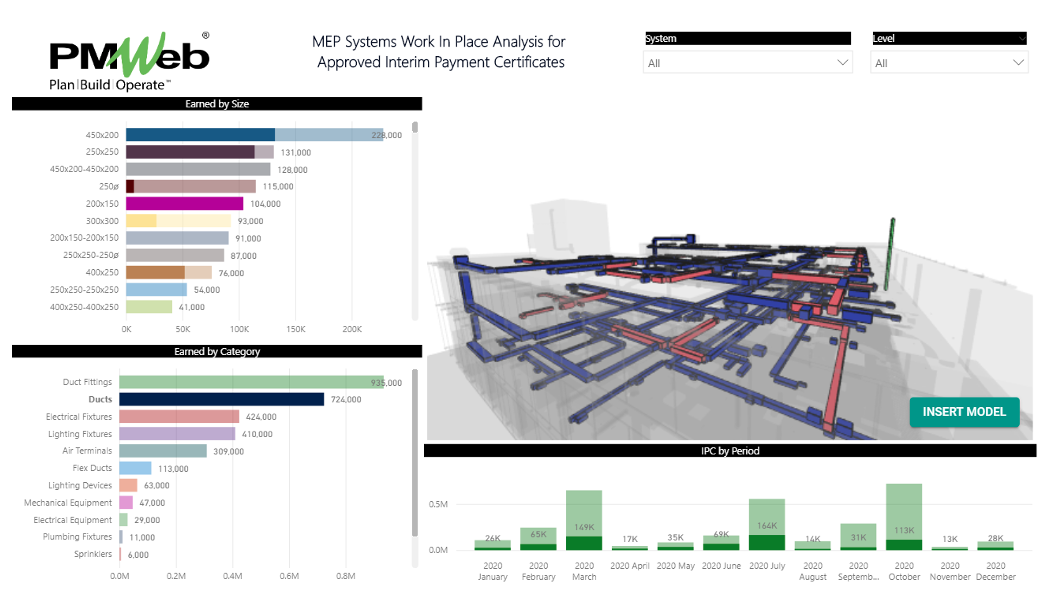
Another option to visualize the captured information is to have a comparison between the earned value for the work in place for two different project periods. In this case, the BIM Model visual coloring needs to be adjusted to reflect the different interim payment certificate periods. In addition, the periods in the “IPC by Period” will need to be modified to also have the same color scheme used in the BIM model visual for the different periods. This will allow the report reader to select the two or more periods to compare the work in place between which will be colored differently for each period in the BIM visual.
What is important to understand is that if the commercial management team and other project stakeholders have trustworthy and traceable data available to them, all created reports will provide a single version of the truth of the project’s commercial performance status regardless of how this information will be displayed or formatted.
